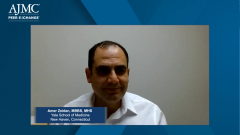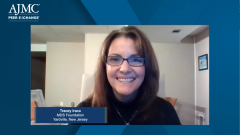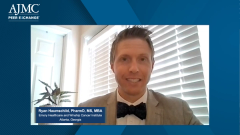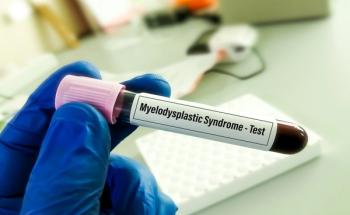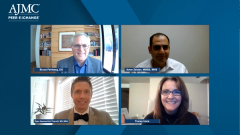
Future Management of Myelodysplastic Syndromes
Panelists look toward the future management of myelodysplastic syndromes with respect to novel agents and treatment pathways.
Episodes in this series

Transcript:
Bruce Feinberg, DO: In our final 5 minutes, I want to do a little future thinking. I’m going to start with you, Tracey. Is there a sense of progress being made with the disease? How is that sense of progress shared with the patients who are seeking information?
Tracey Iraca: There’s a huge sense of progress. I’ve been with the foundation for 17 years. I’ve seen a lot in what’s available to patients and in how the pharmaceutical industry works with patients and patient advocates in companies. The increase of companies being involved in our disease space has exploded. All of those pieces give our patients hope. We make sure that we’re pushing out that information as much as possible. We’re letting them know what’s happening in the field and how many drugs are in clinical trials. There are more options than ever before. Progress is definitely being made. It’s also important for everyone to continue with that progress, to listen even more to patient advocacy organizations, patients, and caregivers, and make sure the patient’s voice is inserted as early as possible in potential new treatments. But progress is being made. It’s a good time.
Bruce Feinberg, DO: Ryan, it’s interesting. I think back to when I was in practice. You mentioned myeloma, but MDS [myelodysplastic syndromes] and myeloma were 2 diseases that would never make your top 10 by virtue of a SEER [Surveillance, Epidemiology, and End Results program] list of common malignancies, like breast, colon, lung, prostate, ovarian, and lymphoma. Yet they were always a top 10 in terms of clinic visits because the patients require so much chronic care. What do you see when you look into the crystal ball in terms of where you think we’re going in MDS based on what you’re seeing at the institution?
Ryan Haumschild, PharmD, MS, MBA: It’s an exciting time for MDS. We’re focused on health care utilization, and that’s come to the forefront, especially when we think of value-based care. When we can create something for these patients that improves their quality of life, reduces their absenteeism, has better management of resources—when we think of blood transfusions and constantly giving ESAs [erythropoiesis-stimulating agents], and as Amer mentioned, better utilizing those infusion chairs for other patients—that creates a huge benefit.
Where do I see us going? I see us utilizing precision medicine to identify patients, creating more strategic pathways that provide better treatment, and considering adherence and persistence. I love to see that digitalness brought into the disease to transform it in terms of adherence. I see us improving that persistence and hopefully providing a reduced total cost of care while getting patients controlled a lot sooner. There are some newer therapies that came out. There’s an exciting future for them. Each of them might have a lot of options, whether it’s dose adjustment based on specific parameters, but it provides better control of disease. So it’s not just thinking, “I live with this chronic cycle of health care utilization,” but instead knowing, “I have a defined plan for my specific type of MDS and I know what the goals are for my therapy and I’m able to persist to reach that end treatment.”
Bruce Feinberg, DO: Tracey, that was good. What do you think?
Tracey Iraca: It was. That’s exactly what we like to hear.
Bruce Feinberg, DO: Amer is going to have to work. I thought he’d be an easy closer, but now I’m not so sure. Amer, focus on the clinical side, because there’s excitement over what’s happening in terms of the research that’s being done, new drugs that are being brought to bear, and the combinations of therapy that may be able to achieve what Ryan described.
Amer Zeidan, MBBS, MHS: On the clinical research front, we’re very excited. I don’t think there has ever been a time when we have had so many drugs in advanced phase development. Each time I’m giving a talk, I’m stunned that we have 5 or 6 different phase 3 drugs for MDS going at the same time in high-risk disease and several in the lower risk, so it’s a very dynamic field. You made the analogy to multiple myeloma. In many ways, we’re going the same direction as with multiple myeloma where we’re making the switch from IV [intravenous] to oral. Then it’s going to be oral doublets or potentially triplets over time, focusing on getting complete responses—we’re probably going to get more complete responses—and trying to think about MRD [minimal residual disease].
These are a lot of things that happened in AML [acute myeloid leukemia] before 2017 and after, a complete revolution. I’m anticipating a similar situation in MDS, but the health policy has to catch up with all of this development because there’s one aspect that has been frustrating in my practice. For example, we talked about the oral HMAs [hypomethylating agents], and in my experience, insurance providers have been good in terms of allowing us to use the drugs. However, those co-pays are ridiculous. The fact that I have some patients who are in their 70s telling me they want to come to the clinic 5 or 7 days a month to get the drug just because they can’t afford the co-pay on an oral pill is just crazy. Something has to be done. There should be variety between oral drugs and injectables. Just because the patient is getting the drug in the clinic, there shouldn’t be a huge difference in their co-pay when they’re taking the drug at home. That’s going to become more of an issue as we get more oral drugs across cancer in general, but that’s probably going to become more of an issue in time in MDS.
Bruce Feinberg, DO: That’s a great point, one that we probably could have spent another half hour on if we had talked about it sooner, but then we wouldn’t have gotten to everything else. We’ll have to leave that one for the next time we get together and talk about MDS.
My thanks to everybody, to Amer Zeidan, Ryan Haumschild, and Tracey Iraca. Thank you all for this rich and informative discussion. Thank you all again for listening and viewing. To those in the audience, we hope you found this AJMC® Peer Exchange to be useful and informative. I’m Bruce Feinberg, and have a great rest of your day. Thank you.
Transcript edited for clarity.
Newsletter
Stay ahead of policy, cost, and value—subscribe to AJMC for expert insights at the intersection of clinical care and health economics.

